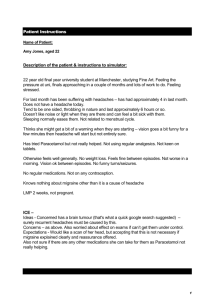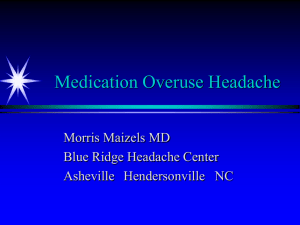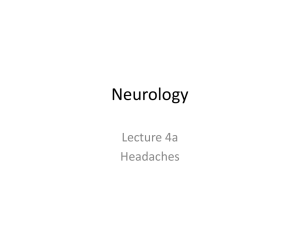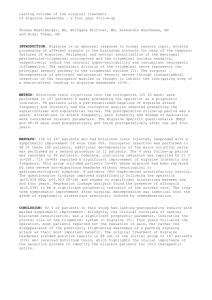Annotated Bibliography
advertisement
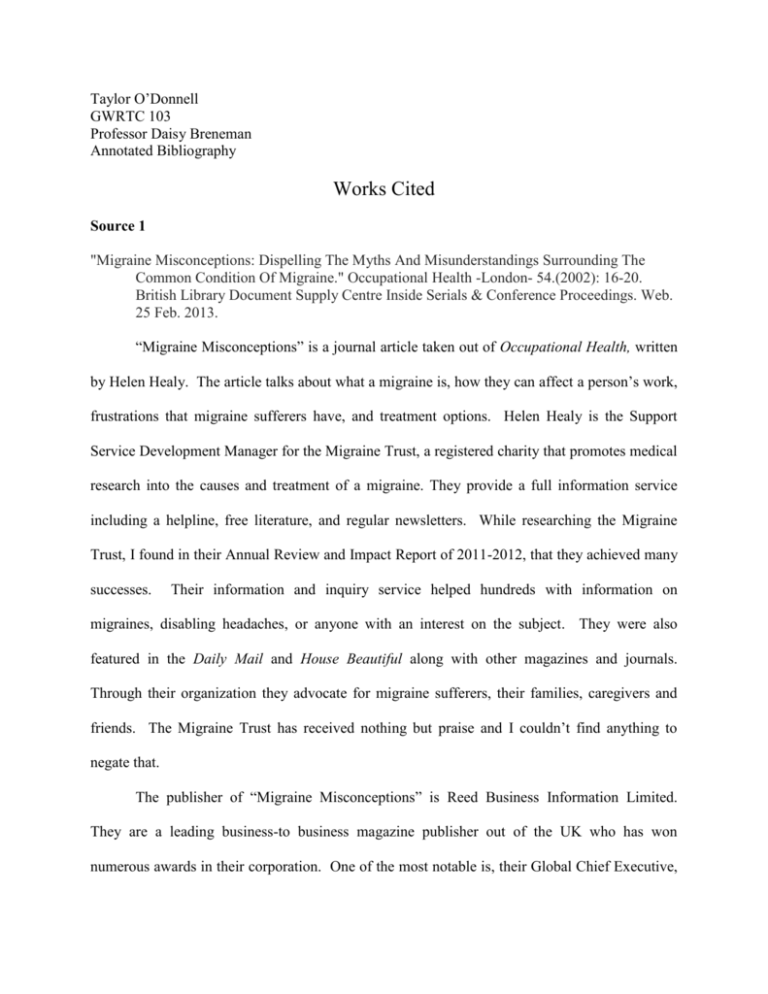
Taylor O’Donnell GWRTC 103 Professor Daisy Breneman Annotated Bibliography Works Cited Source 1 "Migraine Misconceptions: Dispelling The Myths And Misunderstandings Surrounding The Common Condition Of Migraine." Occupational Health -London- 54.(2002): 16-20. British Library Document Supply Centre Inside Serials & Conference Proceedings. Web. 25 Feb. 2013. “Migraine Misconceptions” is a journal article taken out of Occupational Health, written by Helen Healy. The article talks about what a migraine is, how they can affect a person’s work, frustrations that migraine sufferers have, and treatment options. Helen Healy is the Support Service Development Manager for the Migraine Trust, a registered charity that promotes medical research into the causes and treatment of a migraine. They provide a full information service including a helpline, free literature, and regular newsletters. While researching the Migraine Trust, I found in their Annual Review and Impact Report of 2011-2012, that they achieved many successes. Their information and inquiry service helped hundreds with information on migraines, disabling headaches, or anyone with an interest on the subject. They were also featured in the Daily Mail and House Beautiful along with other magazines and journals. Through their organization they advocate for migraine sufferers, their families, caregivers and friends. The Migraine Trust has received nothing but praise and I couldn’t find anything to negate that. The publisher of “Migraine Misconceptions” is Reed Business Information Limited. They are a leading business-to business magazine publisher out of the UK who has won numerous awards in their corporation. One of the most notable is, their Global Chief Executive, Mark Kelsey, was recognized as 2012’s recipient of the Marcus Morris Award. This is the highest award in consumer and business publishing that you can recieve. After looking over their website as well as reviews on the company their has not been any incident that would make the publisher not reputable. This article’s author, Helen Healy, supports and documents the statements made throughout the piece. She consistently gives the reader a fact then backs it up with further information and evidence proving its legitimacy. Healy also covers all aspects of the subtopics of her paper as well. This includes: what is a migraine?, migraines and work, and treating a migraine. She has also been peer reviewed and revised. Throughout this article I identified no extreme bias, her point of view is objective and impartial. Healy focuses on the facts only, but poses a case towards better treatment for migraine sufferers. Her language and tone are unbiased and free of any emotion. If anything, the only way a reader would see where she agrees with one side over the other is in her conclusion where she merely mentions that the above facts should demonstrate on their own that treatment of migraines should be improved. It is not dramatic enough to warrant not using this source, as I feel comfortable with her work. “Migraine Misconceptions” was published in November of 2002. After comparing the facts to a current document, I found the facts hadn’t changed and this article was indeed current enough. The topics that she covers are facts that have remained unchanged over the years that have passed. Healy gives a great background to what a migraine is, how they can affect a persons work and how migraine sufferers feel frustration over others thinking a migraine is just a ‘minor headache’. All of these will be unbelievably useful to my essay. Source 2 Stuart Weatherby, et al. "Behavioural Management Of Migraine." Annals Of Indian Academy Of Neurology (2012): S78-S82. Academic Search Complete. Web. 25 Feb. 2013. Mr. Stuart Weatherby of the United Kingdom wrote “Behavioural Management Of Migraine” along with Helen Brown, Craig Newman and Rupert Noad. Mr. Weatherby is a consultant neurologist at Derriford Hospital in Plymouth. He graduated from Bristol University and trained in general medicine in North Staffordshire and Oxford. Weatherby has developed a particular specialty in headache disorders and migraines which he continually conducts research on. Recently, Weatherby was nominated for the annual Migraine Healthcare Awards by a patient, and won “Best Healthcare Professional”. One of the secondary authors, Helen Brown also won an award for her research with migraines. Ms. Helen Brown is apart of the Clinical Psychology Doctorate Programme at Plymouth University. She recently won an international award from the Anglo- Dutch migraine association for her work on a migraine self-management program. Craig Newman shared this award with Brown; both were recognized for their work on this program. Newman works as a clinical psychologist at Derriford Hospital in Plymouth as well. Finally, Rupert Noad worked on “Behavioural Management of Migraine” as well. Mr. Noad works as a consultant neuropsychologist and is the Head of Neuropsychology within in Neurosciences at Derriford Hospital. “Behavioural Management of Migraine” was published with Medknow Publications based in Mumbai. Medknow offers publication for per reviewed and online and print journals. Their specialty is in print journals based in science, technology, and medicine. As a relatively new company there has been no downturns for this publishing house as of yet. Medknow is used across the globe and is on the upswing for now. With all of the above authors, the overall article is well documented and supported. Each statistic that is presented is cited and sourced along with support from plentiful information. As an entirety this article is based off of scientific and medical research done which are mainly facts and statistics. Considering that this is mainly a factual article, a bias was not an overbearing part of it. While I did not identify any tone or obvious persuasive voice through the article, it was clear that Weatherby and his co-authors supported one idea over the others. I would say that this article leans towards the unbiased though because each idea that was presented was thoroughly explained with both pros and cons. The authors also did a very good job with writing themselves completely out of the article. Not once while I was reading did I find that I heard the authors voice over the facts being presented. Medknow Publications published this article in August of 2012. Being less than a year old, I found this article to be current. For the subject base the work is current enough for further use. The author uses references from a few years ago in his article therefore I feel comfortable that the information has not changed at a rapid pace. A few months ago is a sufficient amount of time to still consider this article current. Furthermore the information in this article has great value. It not only gives options on how to manage a migraine but also how to approach one before it comes. Weatherby gives fantastic statistical background and definite facts that will help to back up major points I am going to make throughout my essay. Finally, Weatherby shows that current literature tends to omit migraines from pain guides. This fact alone can make an argument. Source 3 Seymour Diamond, et al. "Migraine Headache Misconceptions: Barriers To Effective Care." Pharmacotherapy 24.5 (2004): 638-648. Academic Search Complete. Web. 26 Feb. 2013. “Migraine Headache Misconceptions: Barriers to Effective Care” has multiple authors. The primary author is Richard Wenzel. Currently Mr. Wenzel is the Staff Pharmacologist in the Diamond Headache Unit at Saint Joseph Hospital. The Diamond Headache Unit is the oldest and largest private headache center, which is dedicated solely to the diagnosis and management of headache pain. All of which Mr. Wenzel is apart of. The secondary authors include, Marcus Dortch, Roger Cady, Jennifer H. Lofland and Seymour Diamond. Mr. Marcus Dortch is a director in Clinical Pharmacy Services at HealthTrust Purchasing. Formerly Dortch was a Clinical Pharmacist at Saint Joseph’s Hospital. Upon further investigation, Mr. Dortch left Saint Joseph’s Hospital for no other reason than expanding opportunities. Roger Cady, the next secondary author, is the founder of Headache Care Center. The Headache Care Center is a recognized facility for headache and migraine sufferers. Mr. Cady is a well-published author in his own right and continues to be a principal investigator in multiple studies. Ms. Jennifer H. Lofland is working as a researcher in the Office of Health Policy and Clinical Outcomes at Thomas Jefferson University. She has been apart of many studies even though she is just in the beginning of her career. Finally, Seymour Diamond is the founder of Diamond Headache Clinic. Diamond has achieved great successes; among these successes is his winning of the National Migraine Lectureship Award. Mr. Diamond started his career in the early 1960’s and is still an integral part of migraine and headache research. The publisher of “Migraine Headache Misconceptions” is Wiley Publishing. Apart of the larger company John Wiley & Sons, Wiley focuses on academic publishing. Their greatest claim to fame is their publishing of the “For Dummies” books. A more recognizable achievement is their consecutive feature in Forbes Magazine’s “400 Best Big Companies” in America. Although the larger company John Wiley & Sons has had it’s time in the spotlight for some wayward things, Wiley Publishing has escaped untarnished. This gives me confidence that this is a reputable publisher to gain sources from. Throughout this document, Mr. Wenzel consistently backs up his statistics and facts with abundant resources and information. He never says anything without proving his statement and supporting his claim. Another reassuring fact about this article is that it is peer reviewed. While I believe that Mr. Wenzel backs up and supports his claims, he can be biased towards a type of treatment for migraines he finds most helpful. While he may go towards one treatment over the other this source is still credible because he goes over every other treatment plan as well. He does not dismiss another idea without giving it both negative and positive feedback. Wenzel also takes this same approach to his own opinion. The publication date of Wenzel’s article is May of 2004. At first I thought that this may not be current enough but after careful examination of the text I found that it indeed was. Mr. Wenzel and his co-authors work to eliminate old rumors, not necessarily put any new ones into place. The rumors that he and his team dismiss are ones that are still held unreliable to this day, but are still called upon for examination from those who do not understand migraines. The usefulness of this article regarding this detail is crucial to my essay. It is also extremely helpful in giving concrete examples on how different people are affected by migraines and why this is important. This article is not only reliable, but it is very valuable to my research as well. Source 4 Ferrari, Michel D. "Headache: The Changing Migraine Brain." Lancet Neurology 12.1 (2013): 68. MEDLINE. Web. 26 Feb. 2013. “Headache: the Changing Migraine Brain” is an article written by Michel D. Ferrari MD, Ph.D., on how migraines are different from person to person, and migraine to migraine. Mr. Ferrari is a Professor of Neurology as well as the Chair of the Leiden Centre for Transitional Neuroscience at Leiden University Medical Center and the past president of the Headache Society. He also has won numerous awards including The Arnold Friedman Distinguished Clinician Researcher Award and The Harold G. Wolff Award from the American Headache Society, The Migraine Trust Lecture from the British Migraine Trust, The Vici Innovational Research Personal Incentive Schema Award from The Netherlands Organization for Scientific Research, the Winkler Award for Excellence in Neurological Research from the Dutch Neurological Association, and in 2009 the NWO Spinoza Prize, the highest Dutch award in science. Lancet Publication Group publishes a weekly peer reviewed medical journal. This medical journal is called The Lancet, one of the world’s best known, oldest and most respectable medical journals. Lancet Publication Group broke down The Lancet into three separate medical journals, each featuring specialized articles in their respected field. These journals are: The Lancet Oncology, The Lancet Infectious Diseases and The Lancet Neurology, where “Headache: the Changing Migraine Brain” comes from. As one of the oldest Publication groups, Lancet has had a few scandalous articles. At points they have infused some politically controversial research into their journal. This occurred years ago however, and while reading my article I found no hints of political controversy. Michel Ferrari does an excellent job of backing up his article with supporting information as well as documenting statements inside the article. His research is heavily scientific with ample examination of his own work. Not only does Ferrari find his own information, but he reflects on his findings as well as his peers findings. After reading this article multiple times I was surprised by the lack of authors voice throughout the entire article. There was not an I, he, she, or me used once throughout the article. Ferrari wrote in complete academic prose, writing himself out of the article completely. Although he did argue for an idea, every other idea that was presented was equally examined for positive and negative aspects. There was no bias to the point of excluding this article from my research. “Headache: the Changing Migraine Brain” was published in January of 2013. As this was just this past month it is clear that the article is current. Since this article is so current, it gives a great idea as to what is going on this moment in migraine research. It is incredibly useful to my argument to have a reference that is both current and helpful. Ferrari gives a scientifically proved background on what a migraine is as well as how it affects a person. This will come to great use in the beginning of my essay where I explain what a migraine is. Source 5 Young, William (Young). “Just A Headache.” Migraine and Other Headaches. New York: Demos, 2004. Print In Migraine and Other Headaches by William Young, one chapter in particular was analyzed for its information on personal experiences with migraines. “Just a Headache” discusses different stories migraine patients have as well as background information on migraines. William Young, the primary author, is an Assistant Professor of Neurology and Director of the In-Patient Program at the Jefferson Headache Center at Thomas Jefferson University. He is also an active member of the American Academy of Neurology. Young graduated from Haverford College in Pennsylvania then went on to receive his medical degree from Pennsylvania State University College of Medicine. After graduating there Young continued on to intern at Saint Elizabeth’s Hospital in Boston and completed his residency in neurology at Tuft’s University School of Medicine and The New England School of Medicine in Boston. Mr. Young’s co-author, Stephan D. Silberstein is a Professor of Neurology at the Jefferson Medical College of Thomas Jefferson University. Silberstein has done extensive research and investigational drug studies in mostly the treatment of acute migraine headache hormonal migraine and triggers. He has also published many books and publications of his own which are among the most widely studied and recommended. “Just Headaches” was published with Demos Medical Publishing, who publishes highquality professional books for physicians and other healthcare providers. Demos Medical Publishing has been in practice for more than 25 years and has developed an international reputation in the area of neurology. After researching the company thoroughly nothing was found that would discredit them in any way. Young and Silberstein tend to use real life examples to support their statements. I found that in their circumstance it worked very well for supporting their statements. They also document where the information comes from at the end of their book. Facts and figures are prominent as well. In “Just Headaches” there was a good amount of statistical information that backed up the information Young was trying to prove. Even though there are personal experiences throughout the chapter, they were used to demonstrate a real life situation, not to use a bias against a thought or idea. It is clear that the author has an idea that he supports but this does not interfere with the facts presented. Their bias is noted, but it is not done to an extreme nature. The only reason a bias is seen is because they are trying to get the reader to understand that there are misconceptions regarding migraines. No author comes without some kind of bias and I do not believe that this author’s bias gets in the way of the point he is trying to make or the information he presents. Migraines and Other Headaches was published in 2004. Having been a few years since the publication date I was skeptical at first as to how relevant the book could be. After isolating the chapter “Just a Headache” and carefully examining it, I found that for the information presented and the topic it was current enough. Young uses personal experiences for most of the chapter with basic facts about migraines sprinkled in. These facts have not changed over the few short years. To make sure of this I checked a more current document with similar information. In light of the fact that this chapter offers insight into what migraine sufferers go through on a daily basis, I have found it to be an extremely useful resource. The personal experiences of others as well as myself will prove useful in dispelling the idea that a migraine is “just a headache”.
